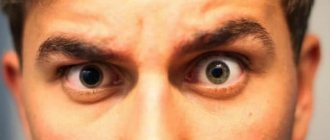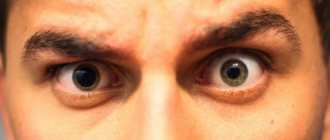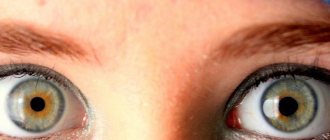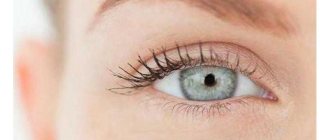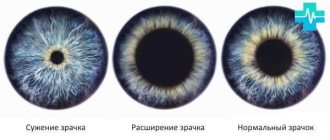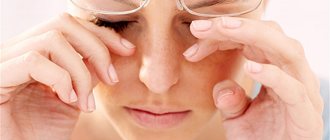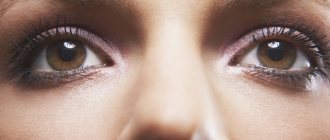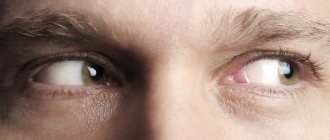Why do your pupils dilate when you look at a person? Physiology of natural pupil dilation
The pupil changes its size due to contractions of the circular and radial muscles. The radial one is responsible for its expansion, and the circular one is responsible for its narrowing. During the day, our pupils constantly change in size for various natural reasons:
- Reaction to light. The pupils dilate in dim light and constrict in bright light. This can be observed if you look into a mirror in a dimly lit room and then turn on a bright light. You will see the pupils shrink. From the outside, this is noticeable in domestic animals, for example, cats. In the morning, their pupils look like narrow stripes, while in the evening they expand to almost the entire eye. The fact is that light passes through the pupil. In bright light or under the sun, it narrows to let in less light and protect nerve cells. When it's dark, your eyes need more light to see better, so your pupils begin to dilate.
- Expression of feelings. When looking at a person for whom we feel love and attraction, the pupils may also enlarge. Scientists have found that this often happens in women when they look at their child, and in men - when they see a naked woman. Interestingly, a person with enlarged pupils seems more visually attractive to the opposite sex. Psychologists recommend making dates in rooms with dim lighting or choosing evening walks in order to increase interest in yourself. An experiment was conducted: men were shown two groups of photographs of one woman. In the second photo, her pupils were slightly enlarged using Photoshop. The men unanimously admitted that she was much more attractive in these photographs. The same result was found when women were shown photos of men with normal and enlarged pupils.
- Emotional condition. The pupils may dilate sharply if a person experiences severe fear, or, conversely, sudden joy, delight, and also excitement. At the same time, they can even increase four times.
- Reaction to eye drops. To carry out some ophthalmological examinations, special mydriatic drops (Irifrin, Atropine and others) are dripped into the eyes, dilating the pupil. After their use, this effect can last up to three days. This phenomenon can also occur when using regular eye irritation drops (“Vizin” and others).
Causes
The pupil is a tiny hole in the iris of the eye that can change its size by regulating the flow of light entering the retina. The most common reasons for changes in pupil size are:
- bright light or darkness.
- emotional experiences.
- taking certain medications.
- use of potent psychotropic substances and drugs.
Also the cause of expansion (mydriasis) are:
- retinal diseases;
- glaucoma;
- traumatic brain injuries;
- aneurysm (pathological expansion of an artery located close to the oculomotor nerve);
- increased intracranial pressure;
- acute lack of oxygen;
- chemical poisoning, drug overdose (for example, barbiturates);
- botulism;
- diseases of the nervous system;
- brain tumors.
Reaction to light
Human eyes are designed in such a way as to protect the retina from the negative effects of external factors, including ultraviolet radiation. Therefore, in bright light, the pupil narrows. And in dimly lit areas, the pupils dilate to provide clear vision. In normal conditions, the diameter of the pupil is about 3 mm, in the dark it increases to 9 mm.
Result of emotions
Attacks of aggression, anger, malice and irritation are accompanied by a surge of adrenaline. In this case, the pupils react instantly. A similar condition is observed during fear and pain, while performing responsible work, if a person is extremely concentrated.
Positive emotions, which release endorphins into the blood, also cause this effect. According to psychologists, positive, open people’s pupils can be constantly dilated. Whereas boring people and pessimists often have constricted pupils.
Sign of illness
Enlarged pupils can occur with head injuries and certain diseases of the thyroid gland and nervous system (epilepsy, stroke, schizophrenia, encephalopathy). If other symptoms are present (feeling unwell, high blood pressure, headache, nausea), you should immediately consult a doctor.
Consequence of treatment
Some drugs have the ability to cause this effect, for example Atropine and Scopalamine, Adrenaline, Gomatropine. The drugs are used in the treatment of various diseases, including ophthalmology. Very often the cause of dilated pupils is the use of eye drops containing tropicamide.
Symptom of addiction
Excessive consumption of alcohol, the use of psychotropic pills and drugs leads to disruption of the processes of contraction and relaxation of the eye muscle.
Chronic dilated pupils
The effect is observed when the optic nerves are partially damaged, since the nerve fibers cannot respond correctly to light. The main symptoms of damage to the optic nerves are pain in the eyes that occurs in bright light, deterioration of twilight vision.
One-way expansion
This is always a pathological symptom that can occur when:
- Eddie's syndrome (hereditary pathology with lack of reaction to light, impaired tendon reflexes and other symptoms);
- ciliary ganglionitis (inflammation of the ciliary vegetative node can develop against the background of diseases of the ENT organs, accompanied by pain in the eyeball, photophobia and lacrimation, redness of the eyes);
- paralysis of the oculomotor nerve (characterized by drooping of the eyelid, partial paralysis of the external eye muscles, blurred vision);
- migraine (during an attack or after it, the pupil dilates on the side where severe headaches are noted);
- injury to the eyeball (the pupil is deformed, hemorrhage occurs).
Emergency conditions
In some cases, the pupils dilate, but there is no reaction to light. This always indicates severe damage to the body and the need for immediate medical attention. This condition may occur in the following cases:
- overdose of medications;
- drug poisoning;
- botulism;
- severe brain injury.
Pupil dilation and nausea in a pregnant woman are a symptom of preeclampsia - a condition dangerous not only to health, but also to life. See a doctor immediately!
Constricted pupils. What does constriction and dilation of pupils mean? Eye pupil signals
The pupils of the eyes are one of the sources of information that allows us to find out how a person feels. The pupils dilate and contract, and this practically does not depend on the person.
Pupil dilation.
Reasons may be related to:
– a decrease in the level of illumination, – a sharp stimulus (light, loud sound), – the pupils are often dilated in alcoholics and heavy smokers and drug addicts.
Also, the reasons may be related to the emotional state: – Fear, – Interest in the opposite sex, – Increased interest in a topic, person, object, – Good mood; elevated, excited state.
Constriction of the pupil.
But an angry and gloomy mood leads to the opposite process - constriction of the pupil. Another reason for constriction is the onset of irritation, anger, hatred and similar negative emotions. Well, it goes without saying that in bright light the pupils constrict and in the dark they dilate.
Visual defects can affect pupil size. Constantly dilated pupils are evidence of a person’s calm and balanced character, while constricted pupils are evidence of a restless and nervous character. When excited, the pupils can enlarge 4 times.
As a result, the pupils signal to us about a person’s condition. And everything that a person feels can be read in the eyes.
If you want to know the truth, look the person in the eyes
The eyes, like the soul of a person, show his inner state. Depending on the mood and lighting, the pupil may expand or contract. When a person is excited, his pupils dilate 4 times their normal state. When a person experiences a feeling of aggression, anger, the pupils, on the contrary, narrow.
There is a theory that when watching pornography, girls do not get aroused - this judgment is incorrect, because... scientists have proven (and you can check it yourself) that a girl gets excited, her pupil enlarges, and even more than that of guys!
Dilated pupils also indicate high feelings of people towards each other. Young couples subconsciously look into each other's eyes, waiting for the pupils to enlarge. Remember yourself or watch other couples, and as already written above, this is also a sign of excitement.
To find out the truth about what a person is saying, you just need to look into his eyes. Professional poker players wear glasses so that their pupils do not reveal their true mood.
Behavior and types of eyes
When a person is dishonest with you or hides something, his eyes meet yours less than 1/3 of the entire time of communication. When you make eye contact for more than 2/3 of the entire conversation, this means: the person considers you an interesting interlocutor or simply attractive (in this case, the pupils are dilated). Or, they are hostile towards you and send a challenge with such a non-verbal gesture (then the pupils will be constricted).
Also, if you look at a person 60-70% of the entire time of communication, then this encourages you to like him. And accordingly, on the contrary, if a person is modest and makes little eye contact, then such a person does not enjoy trust. Business look :
When conducting business negotiations, focus on the forehead of your interlocutor, visually draw a triangle between the eyebrows and forehead and look there. Provided that your gaze does not drop, you will create an atmosphere of seriousness and will be able to control the progress of the negotiations.
Social view:
When you look below the other person's eye level, an atmosphere of social communication is created. And the same visual triangle, only at the level of the eyes and mouth area.
Intimate Look: Passes through the eye line and extends below the chin to other parts of the body. With this look, men and women show their interest in each other. With close contact, the eyes drop to the level of the chest, and with distant contact, to the level of the crotch and legs.
Sideways glance:
If the eyebrows are slightly raised or there is a smile on the street, then this means interest. In women, there is a hidden sexual signal used for enticement. If a sidelong glance is accompanied by downturned eyebrows, a furrowed forehead or downturned corners of the mouth, then this is a suspicious, hostile or critical attitude.
Covered eyelids:
If the eyelids close more often than normal, which is more than 6-8 times a minute, or remain closed for a long time, this is a sign that they have become uninteresting to the interlocutor, he is trying to erase you from sight. If at the same time your interlocutor throws his head back and accompanies this with a long look, this means that he feels superior to you
How to control your interlocutor's gaze:
Information comes best through visual images. If you want to attract the attention of the recipient and achieve maximum assimilation of information for him, then there is a very easy technique for this. Take a pen, pointer or something similar and show it on a visual aid (board, paper, drawings, etc.), and then raise the pen to the level of his and your eyes, the recipient’s head will automatically rise behind the pen and then he will be able to absorb as much as possible information (remember school, how the teacher focused your attention).
Dilated pupils in a child. Physiological causes of pupil dilation
The reasons why your pupils are dilated do not necessarily have to be related to illness. It could be:
- insufficient lighting in which you view the pupils. In this case, the dark circle in the middle of the iris can reach 8 mm, and even after exposure to light it can remain enlarged for 1-2 minutes;
- a person who has mydriasis is now experiencing strong emotions. This could be panic, fear, anger - everything that causes the release of adrenaline into the blood and its effect on the sympathetic nervous system, which dilates the pupil;
- if a person whose pupils are dilated looks at the object of his sympathy/love or thinks about it. The cause of mydriasis in this case is the same - activation of the sympathetic nervous system.
How to understand that dilated pupils are caused by reasons not related to the disease? In this case:
- The pupils react to light: if you direct the light from a light bulb or flashlight into both eyes, the pupil will constrict immediately, but if the flashlight is directed at one eye, both pupils should constrict simultaneously, in a second or less.
- A person can puff out his cheeks, bare his teeth, close his eyes tightly - and at the same time his face will be symmetrical: no drooping of the corner of the mouth, incomplete closing of the eye, or blowing air out of a sagging cheek.
- Eyes don't hurt; they are not red or watery.
- There is no headache or nausea, especially in the morning.
- The sensitivity of the arms and legs, as well as movements in them, are preserved.
- Body temperature is neither higher nor lower than normal values.
What else can dilate the pupils?
Anything, really. Almost every vivid emotion is capable of this, but especially fear, excitement and joy (all for the same reason the activation of hormones that trigger the process of preparing the body for fight or flight). Also: changes in light levels, alcohol, certain medications, eye injuries, and ovulation.
In short, dilated pupils are not necessarily a marker of sympathy or love. But they, of course, are not necessarily a marker of something else.
Dilated pupils in a teenager. Signs of using different types of drugs
Marijuana is a type of recreational drug. Glazed look, red eyes. Talks loudly, laughs for no reason. He is overcome by drowsiness, noticeable loss of motivation, and weight gain/loss.
Depressants: The behavior of a teenager resembles that of a drunk person. For example, he has difficulty concentrating. His slurred speech gives him away. Clumsiness, short-sightedness, and drowsiness are characteristic signs of depressant abuse.
Stimulants (including crystal methamphetamine, amphetamines, cocaine). The teenager is shown by dilated pupils, hyperactivity, and euphoria. He becomes irritable or excessively talkative. Food, sleep - he is of little interest under the influence of stimulants, which has not been observed before. Noticeable weight loss.
Inhalants (adhesives, aerosols, vapors): Watery eyes; blurred vision, memory, thoughts; bloody discharge from the nose. A rash is noticeable around the nose and mouth. Constant companions and signs of drug addiction to inhalants are headaches and nausea. Intoxication, drowsiness, muscle cramps, changes in appetite, anxiety, irritability. The number of aerosol cans in the trash can may also indicate a sign.
Hallucinogens (LSD, PCP): Strange irrational behavior, paranoia, hallucinations. Those taking hallucinogens experience frequent mood swings: from aggression to complete indifference and insensitivity. Slurred speech, confusion, and reclusiveness are noted.
Heroin: Lack of reaction to light; sweating, sobbing, vomiting, twitching, loss of appetite.
According to medical professionals, narcologists: in order to technically classify the diagnosis of drug addiction, a person must: 1) display one or more of the symptoms listed above for at least a year; 2) if the simultaneous manifestation of five signs from the list is detected, then drug addiction has settled in the house.
The risk of drug abuse increases significantly during times of life change or upheaval, such as changing schools, moving homes, or divorcing parents. Therefore, the task of parents is to see the difference between the usual, normal state of a teenager and signs of drug use.

